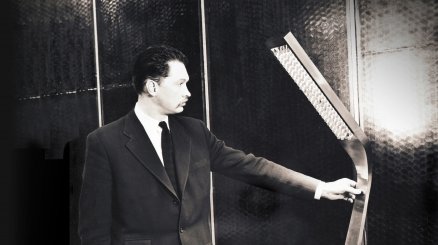A retrospective exhibition of the work of Jules Wabbes, one of Belgium’s greatest post-war designers, is running at the Palais des Beaux-Arts (‘Bozar’) in Brussels until 13 January. His last-ever commission was the interior design of the headquarters of the BNP Paribas Fortis forerunner Generale Bank, for which he also created furniture. Some key pieces are on show at the exhibition.
Although not widely known among the general public, Jules Wabbes (1919-1974) has nevertheless for many years enjoyed the recognition and respect of his peers. In 1960, his inventiveness and dedication to simple, pure lines brought him the gold medal at the Milan Triennale. The Bozar exhibition, which opened on 17 October and closes on 13 January, pays tribute to this talented creator. Jules Wabbes’ passionate devotion to the development of interior design won him commissions from numerous well-known individuals and companies. Among his creations were the interior trim and seats of the Sabena passenger aircraft cabins; the fitting out of the Science Library at the University of Louvain-La-Neuve, the Glaverbel headquarters building and the United States embassies at The Hague, Rabat and Dakar; and the large hexagonal lamp designed for the restaurant of the Belgian pavilion at the Osaka World Fair in 1970.
His last-ever commission was the interior design of the headquarters of the BNP Paribas Fortis forerunner Generale Bank fronting on to the rue Ravenstein in Brussels. Starting in 1971, Wabbes worked in collaboration with three architects on the refurbishment of the banking hall, the strongroom with its ceiling designed in the form of gold fish scales, the elevator areas and the management floors. His idea was to ensure that the bank projected an image of rigorousness and reliability by choosing high-quality but sober materials such as Italian granite for the paving and walls and metals – specifically bronze and brass – for the door handles and frames and call buzzers. Even for the non-public areas, he maintained a clean, stripped-down style. Jules Wabbes also created furniture for the offices and meeting rooms and the Bank has managed to preserve the most significant pieces: light fittings, writing desks and meeting-room tables with legs in tulip-form, filing cabinets, mobile cabinets and Bergwood bureaux. Here again, Wabbes used precious materials such as exotic woods combined with chrome steel in order to leave a timeless signature in simple and durable forms.
This furniture today forms part of BNP Paribas Fortis’ artistic and historical heritage. As part of our policy of cultural philanthropy, the Bank has had a number of these pieces restored and they are now on show at the Jules Wabbes retrospective.
Contact at BNP Paribas Fortis: Dominique Van Hove, in charge of Arts Collection & Historical Archives
For more information about furniture designer Jules Wabbes and the retrospective
